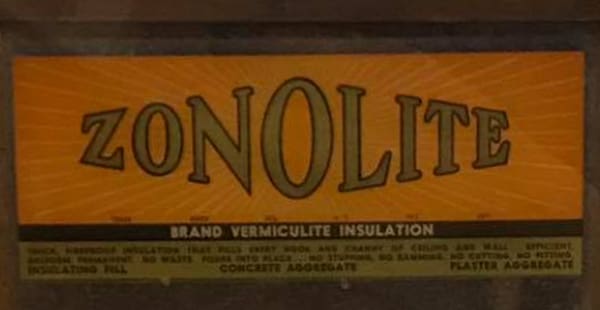Why Was Asbestos Used in Zonolite Insulation?
Vermiculite insulation is an efficient material for insulating buildings. It is lightweight and fire-resistant, making it a popular choice. Unfortunately, some vermiculite may be contaminated with asbestos. Zonolite insulation came from the notorious Libby, Montana, vermiculite mine. This vermiculite was contaminated with asbestos, so products like Zonolite were too.
The Zonolite Company began mining vermiculite outside of Libby in 1919. The mine had a tremolite asbestos deposit mixed in with the vermiculite. Standard mining operations likely caused asbestos to contaminate the Zonolite vermiculite.
Between the 1940s and the mid-1980s, Zonolite insulation was popular. Many builders used it in homes across the country. By some estimates, millions of homes may have Zonolite insulation.
Asbestos Zonolite Insulation History at a Glance
- Other Names: Vermiculite insulation
- Years of Manufacture: 1940 – 1984
- Places Used: Attics
- Asbestos Use Banned: No
- Noteworthy Brands: W.R. Grace, Zonolite
The Zonolite Company was the first to manufacture Zonolite insulation. In 1963, W.R. Grace & Company bought the company and sold the insulation products until 1984.
During the 1980s, asbestos laws were enacted to regulate its use in the United States. Although Zonolite Attic Insulation is no longer manufactured, many homes may still contain it.
Dangers of Asbestos in Zonolite Insulation
Vermiculite may not be dangerous by itself. But it becomes dangerous when asbestos contaminates it. Unfortunately, much of the vermiculite in the United States is contaminated with asbestos. Approximately 80% of America’s vermiculite came from the Libby mine.
In a 2012 study, researchers tested vermiculite attic insulation in 46 homes. Amphibole asbestos was present in 40 of the insulation samples. The Environmental Protection Agency (EPA) suggests homeowners assume all vermiculite insulation may be contaminated.
Zonolite attic insulation crumbles easily, releasing asbestos dust into the air. When asbestos becomes airborne, people may inhale or ingest it. Once in the body, asbestos can lead to asbestosis, lung cancer or mesothelioma.
For safety, the EPA suggests homeowners who suspect the presence of asbestos in their vermiculite insulation:
- Avoid storing items in the attic
- Hire a qualified asbestos abatement professional to remove the insulation
- Minimize the time they spend in the attic
If you have vermiculite insulation in your home, contact a qualified asbestos inspector. Only properly trained professionals should handle asbestos products.
Other Zonolite Products Manufactured by W.R. Grace
The Zonolite Company began selling its vermiculite insulation in 1940. In 1963, W.R. Grace bought Zonolite and its operations in Libby. The Zonolite name became a brand sold by W.R. Grace. Many of the Zonolite-brand products also used asbestos.
Zonolite-brand products manufactured by W.R. Grace include:
| Product Name | Start Year | End Year |
|---|---|---|
| Perltex Super-40 Perlite | 1966 | 1973 |
| Zonolite Acoustical Plaster | 1945 | 1972 |
| Zonolite High Temperature Insulating Cement | 1945 | 1972 |
| Zonolite Mono-Kote (MK-3) | 1959 | 1973 |
| Zonolite Spra-Insulation | 1960 | 1973 |
| Zonolite Spra-Tex | 1955 | 1972 |
These products were made with asbestos-contaminated vermiculite. Anyone who comes in contact with Zonolite products may risk asbestos exposure.
Who Is at Risk of Asbestos Exposure From Zonolite Insulation?
Zonolite attic insulation can expose people to asbestos fibers if it is disturbed. Some occupations that may be exposed include construction workers and contractors. These workers may unknowingly disturb asbestos-contaminated vermiculite during renovations or demolition. Homeowners performing do-it-yourself repairs face the same risks.
Many older homes still have Zonolite insulation. Until an asbestos abatement professional removes it, homeowners should avoid vermiculite insulation. It may pose an asbestos exposure risk until it is safely removed.
W.R. Grace also put their employees in danger. Those working in the Libby vermiculite mine may have inhaled asbestos dust without knowing. The employees at the processing plant faced exposure risks, too.
Asbestos exposure from Zonolite insulation can lead to asbestos-related diseases. Anyone who develops these diseases from their exposure may qualify for compensation. A mesothelioma lawyer can manage the entire legal process for clients.
Asbestos Lawsuits, Settlements and Other Compensation
W.R. Grace had thousands of lawsuits filed against it over Zonolite insulation and other products. At one point, the company faced more than 65,000 asbestos-related lawsuits. These lawsuits involved almost 130,000 plaintiffs.
In 2001, the company sought protection against these lawsuits. It filed for Chapter 11 bankruptcy and established two separate asbestos trust funds:
- W.R. Grace & Company Personal Injury Trust: The company created this trust fund for current and future victims. Anyone who develops mesothelioma or other asbestos illnesses caused by W.R. Grace’s products may qualify.
- The Zonolite Attic Insulation Trust: This trust fund helps cover costs involved with asbestos remediation. Homeowners can use it to cover some encapsulation or abatement costs. The trust may reimburse claimants for up to 55% of the remediation costs.
The company funded the trusts with more than $4 billion combined. Both trusts use a payment percentage to pay out eligible claimants. This ensures the trusts can maintain funds for future claimants. W.R. Grace began accepting trust fund claims in 2014.
Patients and their families can use compensation from an asbestos trust fund claim to help cover expenses. This money may help cover treatment costs, lost income and other expenses.






